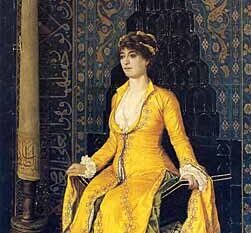Osman Hamdi Bey’s Mihrap (1901) is one of his most intriguing works, offering a deep exploration of religion, culture, and identity through the lens of art. A meticulous painter, archaeologist, and cultural reformer, Osman Hamdi Bey used his art to reflect the complex interplay of Ottoman traditions and the influences of modernization. Mihrap, which depicts a prayer niche central to Islamic religious practice, serves as a profound statement on spirituality, heritage, and the timeless beauty of religious devotion.
In this article, we delve into the cultural significance of Mihrap, examining its artistic elements, historical context, and the broader cultural themes it conveys in light of contemporary perspectives.
The Symbolism of the Mihrap
A mihrab is an architectural feature in mosques, indicating the direction of Mecca (the qibla), where Muslims face during prayer. More than a structural element, the mihrab embodies the centrality of faith in Islamic culture, serving as a spiritual focal point for communal worship and individual reflection. Osman Hamdi Bey’s choice to feature this sacred symbol in his painting underscores its cultural and spiritual importance, while also inviting viewers to contemplate its aesthetic and architectural beauty.
In Mihrap, Osman Hamdi Bey captures the intricate artistry of Ottoman mosque design, with delicate arabesque patterns, geometric motifs, and Quranic inscriptions. The painting goes beyond mere representation, celebrating the harmony between religious devotion and artistic craftsmanship.
Artistic Elements: Tradition Meets Modernity
Osman Hamdi Bey’s Mihrap exemplifies his unique ability to merge Western painting techniques with Ottoman-Islamic themes. The painting’s composition is grounded in realism, with careful attention to detail and light, hallmarks of his European artistic training. The intricate decorations of the mihrab—including floral and geometric patterns—are rendered with extraordinary precision, showcasing his reverence for Islamic art.
One striking feature of the painting is its use of light and shadow. Osman Hamdi Bey illuminates the mihrab with a warm, almost ethereal glow, suggesting the divine presence and the spiritual significance of the space. The muted background contrasts with the richly detailed mihrab, drawing the viewer’s attention to its beauty and symbolic weight.
Unlike many of his contemporaries in the Orientalist tradition, Osman Hamdi Bey approached his subjects from an insider’s perspective, avoiding exoticization or romanticized portrayals. His depiction of the mihrab reflects a deep understanding and respect for Islamic culture, combining artistic elegance with cultural authenticity.
Historical Context: Osman Hamdi Bey’s Vision
Osman Hamdi Bey painted Mihrap during a period of rapid social and political transformation in the Ottoman Empire. The late 19th and early 20th centuries were marked by efforts to modernize and Westernize various aspects of Ottoman society, from governance to education and art. Amid these changes, Osman Hamdi Bey sought to bridge the gap between tradition and modernity.
His work on Mihrap can be seen as a response to the challenges of preserving Ottoman-Islamic heritage while embracing the advances of Western art. By focusing on a quintessentially Islamic architectural feature, Osman Hamdi Bey reasserted the importance of cultural identity in an era of globalization. At the same time, his adoption of Western artistic techniques highlighted his openness to innovation and cross-cultural exchange.
The painting also reflects Osman Hamdi Bey’s role as a cultural reformer. As the founder of the Sanayi-i Nefise Mektebi (Academy of Fine Arts), he championed the idea that art could serve as a vehicle for cultural preservation and renewal. Mihrap exemplifies this vision, merging the old and the new in a harmonious dialogue.
Cultural Reflections in the Modern Era
In the 21st century, Mihrap continues to resonate with audiences, offering timeless insights into the relationship between religion, art, and culture. Its intricate details remind us of the rich artistic traditions of the Islamic world, while its realistic rendering speaks to the universality of beauty and craftsmanship.
From a modern perspective, Mihrap can also be interpreted as a call to celebrate and preserve cultural heritage in a rapidly changing world. In an age where traditional art forms often risk being overshadowed by modern trends, Osman Hamdi Bey’s work stands as a testament to the enduring relevance of cultural identity.
Moreover, the painting invites contemporary viewers to reflect on the role of art in spiritual expression. By focusing on a sacred space that transcends time and geography, Mihrap underscores the universal human desire for connection, meaning, and beauty.
The Legacy of Mihrap in Osman Hamdi Bey’s Oeuvre
Among Osman Hamdi Bey’s body of work, Mihrap occupies a unique place as a celebration of Islamic artistry and spirituality. While many of his other paintings, such as The Tortoise Trainer and Women in the Mosque, focus on human figures and social themes, Mihrap shifts the spotlight to architectural and cultural symbolism. This choice underscores his versatility as an artist and his commitment to preserving Ottoman-Islamic heritage in all its forms.
The painting’s legacy also extends to its influence on modern Turkish art. As a forerunner of the integration of traditional themes with contemporary techniques, Osman Hamdi Bey paved the way for future generations of artists to explore their cultural roots while engaging with global artistic movements.
Osman Hamdi Bey’s Mihrap is more than a painting; it is a window into the spiritual and cultural soul of the Ottoman Empire. Through its meticulous detail, masterful composition, and profound symbolism, the painting invites viewers to contemplate the beauty of religious devotion and the importance of cultural heritage.
In our modern world, where the intersection of tradition and innovation remains a central challenge, Mihrap serves as a poignant reminder of the transformative power of art. By bridging the past and the present, Osman Hamdi Bey’s masterpiece continues to inspire, urging us to honor our shared history while embracing the possibilities of the future.
As we stand before the luminous mihrab he so lovingly depicted, we are reminded of the enduring connection between art, culture, and the divine—a connection that transcends time, borders, and civilizations.

